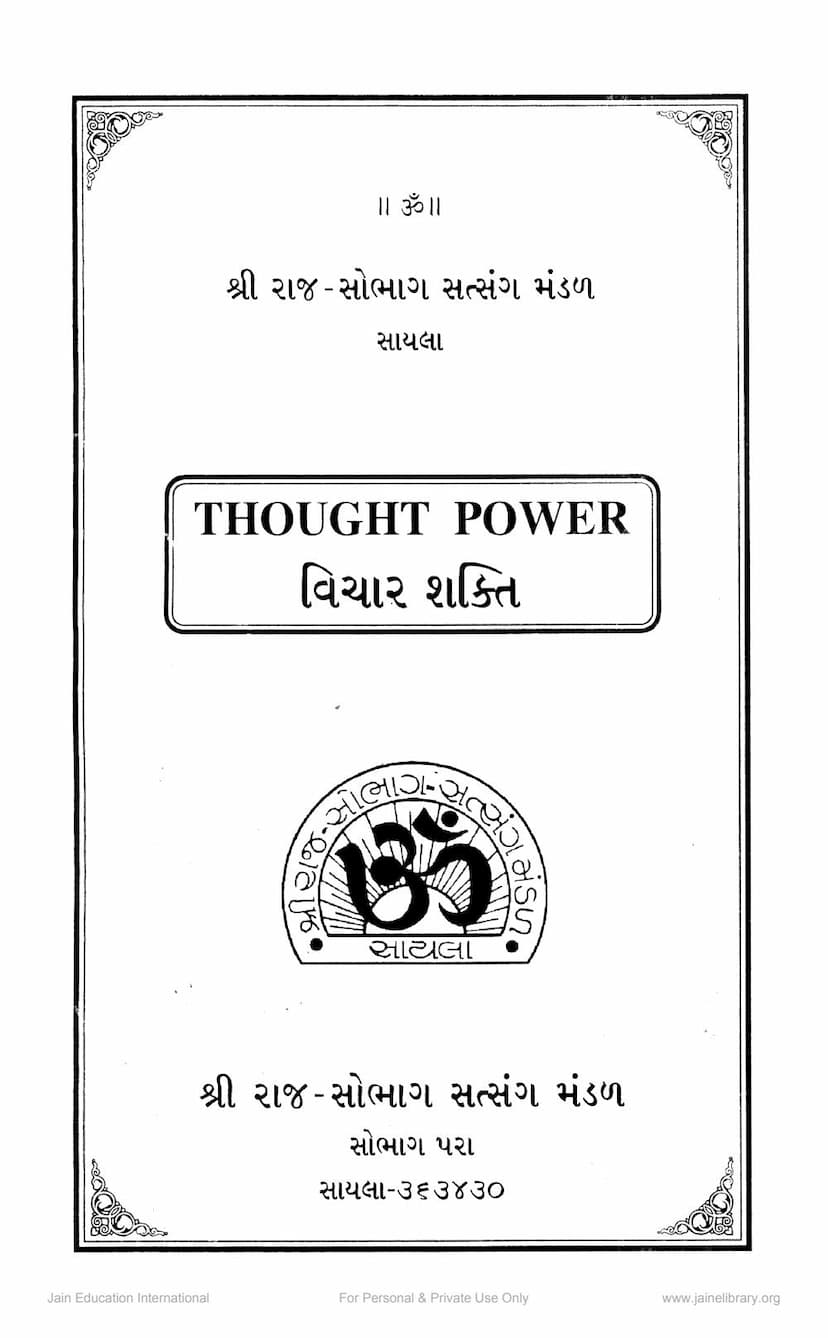Vichar Shakti
Added to library: September 2, 2025

Summary
Here's a comprehensive summary of the Jain text "Vichar Shakti" (Thought Power):
Book Title: Vichar Shakti (Thought Power) Author(s): Shivanand Swami, Raj Saubhag Editorial Committee Publisher: Raj Saubhag Satsang Mandal Sayla
This Jain text, "Vichar Shakti," is a profound exploration of the power of thought and its central role in spiritual progress and liberation, deeply rooted in Jain philosophy. It emphasizes that thoughts are not mere mental occurrences but potent forces that shape our reality, our destiny, and our spiritual journey.
Here's a breakdown of the key themes and teachings:
1. The Nature and Power of Thoughts:
- Thoughts Create Our World: The book asserts that our entire reality is a projection of our mind. "Mano Matram Jagat" (The world is only the mind) is a core concept. Our experiences of pleasure and pain, friendship and enmity, good and evil, are all products of our own imagination and thoughts.
- Thoughts are Creative Forces: Thoughts have the power to bring things into existence, develop desires, and excite passions. They are the fundamental building blocks of our character and our destiny.
- The Mind as the Root: The mind, and its thoughts, are identified as the root cause of the cycle of birth and death (Samsara). Controlling the mind and its thoughts is paramount for liberation.
- Mind is Mayaic: The mind is described as a product of the Atman's Maya (illusory power), a powerful force that can lead to both bondage and liberation.
2. The Path to Liberation through Thought Control:
- Extinction of Thoughts is Moksha: True liberation (Moksha) is achieved through the cessation of thoughts and desires (Vasanas). This state of thoughtlessness leads to the annihilation of the mind and the experience of the timeless reality (Kaivalya).
- Renunciation of Thoughts Leads to Liberation: The expansion of thoughts towards material objects is considered bondage, while the renunciation of these thoughts is liberation.
- Purification and Control of the Mind: The central aim of all spiritual practices (Yogas) is the purification and control of the mind and its thoughts. This involves understanding the mind's nature, habits, and tricks.
3. Practical Guidance for Cultivating Thought Power:
- Avoid Useless Information: Do not clutter the mind with useless information. Learn to "unmind the mind" to make space for divine thoughts.
- Right Thinking is Essential: The book strongly advocates for "right thinking." This means focusing on noble, divine, and positive thoughts.
- Purify Thoughts: Purity of thought is crucial and is linked to purity of "food" (what we gather through our senses).
- Control Desires and Emotions: Desires (Vasanas) and emotions, particularly anger, lust, and pride, are major drivers of negative thoughts. Controlling these is vital.
- Practice Concentration and Meditation: Regular concentration and meditation are presented as the primary tools for quieting the mind and gaining mastery over thoughts.
- Substitute Negative with Positive: When negative thoughts arise, the recommended approach is not to directly fight them but to substitute them with positive, divine thoughts. This is described as a gentle yet effective method.
- Mindfulness and Witnessing: Developing the ability to be a witness (Sakshi bhava) to one's thoughts, without judgment or attachment, is a key practice.
- Reduce Wants and Activities: Reducing worldly desires and engaging in silence helps in concentrating the mind.
- The Power of the Last Thought: The book emphasizes that the last thought at the time of death determines the next birth. Therefore, cultivating positive and spiritual thoughts throughout life is essential.
4. Key Concepts and Analogies:
- "Mano Matram Jagat": The world is mind.
- "As a man thinketh, so he becometh": This fundamental principle is reiterated throughout the text.
- Mind as a Gramophone Record: Thoughts are imprinted on our face like a gramophone record.
- Mind as a Playful Child: The mind needs constant discipline and guidance.
- Mind as a Monkey: The mind is compared to a jumping monkey that needs to be trained.
- Thoughts as Seeds: Just as a seed yields a fruit, thoughts yield actions. Good thoughts yield good actions, and vice versa.
5. The Role of the Self and the Guru:
- Self-Reliance and Effort: The book stresses the importance of self-reliance and personal effort ("Purushartha") in shaping one's destiny. Fatalism is discouraged as it leads to inertia.
- The Inner Teacher: Man is his own guru for his destiny.
- Guru's Grace: While Guru's grace is unconditional, it is experienced by the disciple who maintains self-discipline and inner purity.
6. Spiritual Growth and Transformation:
- Purity Leads to Wisdom and Immortality: Mental and physical purity are essential for wisdom and liberation.
- Positive Thoughts Foster Health and Well-being: Cheerful, joyful, and courageous thoughts heal, soothe, and augment efficiency. Negative thoughts cause damage and illness.
- Spiritual Progress is Gradual: Overcoming negative thoughts and achieving mental stillness is a process that requires patience, persistence, and regular practice. Even small progress, like experiencing anger less frequently, is a sign of spiritual growth.
- The Goal is Self-Realization: The ultimate goal is to realize the true Self (Atman), which is beyond the body and the ever-changing mind.
In essence, "Vichar Shakti" is a practical guide for anyone seeking spiritual development. It provides a comprehensive framework for understanding the immense power of our thoughts and offers actionable strategies to harness this power for self-transformation, leading to inner peace, well-being, and ultimately, spiritual liberation.